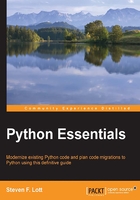
Summary
We've looked at some core data types available in Python. We've looked at five different kinds of numbers, including integers, floating-point, complex, Fraction and Decimal. Each fills a different niche. Three of these are built-in, the other two must be imported from the standard library.
We've also looked at three different kinds of collections. The tuple is a simple sequence of items with relatively few methods. str is a Unicode string, which has several methods for creating new strings as transformations of existing strings. bytes is a byte string, which also has a variety of methods. We can decode bytes to create Unicode strings. We can encode Unicode strings into bytes.
We've touched on how the import statement is used to introduce new types and new modules. This will add features from the standard library.
We've also looked at a number of functions to convert various numeric types. Many of these functions also convert strings to numbers. We'll make heavy use of int() and float() to convert strings to numbers. The reverse—converting numbers to strings—can be done with the str() function. It can be done better, however, with the formatting tools we'll look at in the next chapter.
In Chapter 3, Expressions and Output, we'll build on these basic concepts. We'll look in more depth at Python language syntax. We'll also look at functions for creating nicely formatted output. This will allow us to write simple programs. In Chapter 4, Variables, Assignment and Scoping Rules, we'll add even more essential language features so that we can write more sophisticated programs.